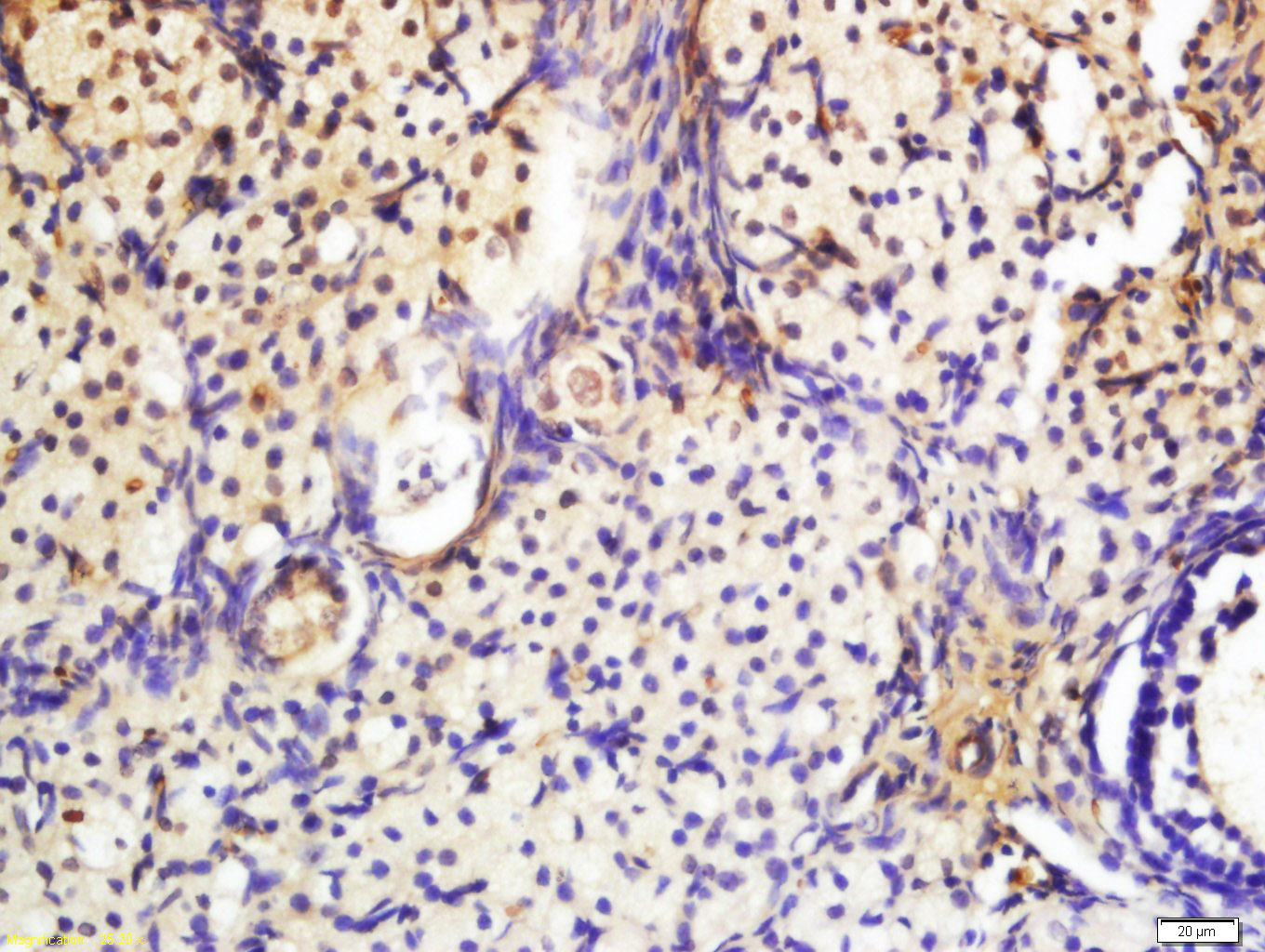
Rabbit Anti-Phospho-PAK2 (Ser20)antibody
PAK2 (phospho S20); PAK2 (phospho Ser20); p-PAK2 (S20); p-PAK2 (Ser20); CB422; EC 2.7.11.1; Gamma PAK; hPAK65; Kinase; p21 (CDKN1A)-activated kinase 2a; p21 activated kinase 2; p21 protein (Cdc42/Rac)-activated kinase 2; p21 protein Cdc42 Rac activated ki
View History [Clear]
Details
Product Name Phospho-PAK2 (Ser20) Chinese Name 磷酸化p21激活激酶2抗体 Alias PAK2 (phospho S20); PAK2 (phospho Ser20); p-PAK2 (S20); p-PAK2 (Ser20); CB422; EC 2.7.11.1; Gamma PAK; hPAK65; Kinase; p21 (CDKN1A)-activated kinase 2a; p21 activated kinase 2; p21 protein (Cdc42/Rac)-activated kinase 2; p21 protein Cdc42 Rac activated kinase 2; p21-activated kinase, 65-KD antibody p21-activated protein kinase I; p21CDKN1A activated kinase 2; p58; p65PAK; PAK 2; PAK65; PAKgamma; S6 H4 kinase; Serine threonine protein kinase PAK 2. Product Type Phosphorylated anti Research Area Tumour immunology Signal transduction Apoptosis transcriptional regulatory factor Kinases and Phosphatases Immunogen Species Rabbit Clonality Polyclonal React Species Mouse, (predicted: Human, Rat, Dog, Cow, Horse, Rabbit, Sheep, ) Applications ELISA=1:5000-10000 IHC-P=1:100-500 IHC-F=1:100-500 IF=1:100-500 (Paraffin sections need antigen repair)
not yet tested in other applications.
optimal dilutions/concentrations should be determined by the end user.Theoretical molecular weight 58kDa Cellular localization The nucleus cytoplasmic The cell membrane Form Liquid Concentration 1mg/ml immunogen KLH conjugated Synthesised phosphopeptide derived from human PAK2 around the phosphorylation site of Ser20: MS(p-S)TI Lsotype IgG Purification affinity purified by Protein A Buffer Solution 0.01M TBS(pH7.4) with 1% BSA, 0.03% Proclin300 and 50% Glycerol. Storage Shipped at 4℃. Store at -20 °C for one year. Avoid repeated freeze/thaw cycles. Attention This product as supplied is intended for research use only, not for use in human, therapeutic or diagnostic applications. PubMed PubMed Product Detail The p21 activated kinases (PAK) are critical effectors that link Rho GTPases to cytoskeleton reorganization and nuclear signaling. The PAK proteins are a family of serine/threonine kinases that serve as targets for the small GTP binding proteins, CDC42 and RAC1, and have been implicated in a wide range of biological activities. The protein encoded by this gene is activated by proteolytic cleavage during caspase-mediated apoptosis, and may play a role in regulating the apoptotic events in the dying cell.
P21-activated kinase (PAK) is actually a family of serine/threonine protein kinases, members of which are activated by small molecular weight GTPases. The three most common isoforms are PAK 1, PAK 2, and PAK 3 (also known as alpha PAK, gamma PAK, and beta PAK, respectively). These kinases contain numerous regulatory elements that trigger diverse signaling processes such as those initiated by activated GTPases, interaction with Src homology 3 (SH3) domains, and caspase mediated proteolytic cleavage. Autophosphorylation of serine 141 (serine 144 for PAK 1 and serine 139 PAK 3), catalyzed by Cdc42, is required for activation of PAK.
Function:
Serine/threonine protein kinase that plays a role in a variety of different signaling pathways including cytoskeleton regulation, cell motility, cell cycle progression, apoptosis or proliferation. Acts as downstream effector of the small GTPases CDC42 and RAC1. Activation by the binding of active CDC42 and RAC1 results in a conformational change and a subsequent autophosphorylation on several serine and/or threonine residues. Full-length PAK2 stimulates cell survival and cell growth. Phosphorylates MAPK4 and MAPK6 and activates the downstream target MAPKAPK5, a regulator of F-actin polymerization and cell migration. Phosphorylates JUN and plays an important role in EGF-induced cell proliferation. Phosphorylates many other substrates including histone H4 to promote assembly of H3.3 and H4 into nucleosomes, BAD, ribosomal protein S6, or MBP. Additionally, associates with ARHGEF7 and GIT1 to perform kinase-independent functions such as spindle orientation control during mitosis. On the other hand, apoptotic stimuli such as DNA damage lead to caspase-mediated cleavage of PAK2, generating PAK-2p34, an active p34 fragment that translocates to the nucleus and promotes cellular apoptosis involving the JNK signaling pathway. Caspase-activated PAK2 phosphorylates MKNK1 and reduces cellular translation.
Subunit:
Interacts tightly with GTP-bound but not GDP-bound CDC42/p21 and RAC1. Interacts with SH3MD4. Interacts with and activated by HIV-1 Nef. Interacts with SCRIB. Interacts with ARHGEF7 and GIT1. PAK-2p34 interacts with ARHGAP10.
Subcellular Location:
Serine/threonine-protein kinase PAK 2: Cytoplasm. Note=MYO18A mediates the cellular distribution of the PAK2-ARHGEF7-GIT1 complex to the inner surface of the cell membrane. PAK-2p34: Nucleus. Cytoplasm, perinuclear region. Membrane; Lipid-anchor. Note=Interaction with ARHGAP10 probably changes PAK-2p34 location to cytoplasmic perinuclear region. Myristoylation changes PAK-2p34 location to the membrane.
Tissue Specificity:
Ubiquitously expressed. Higher levels seen in skeletal muscle, ovary, thymus and spleen.
Post-translational modifications:
Full length PAK2 is autophosphorylated when activated by CDC42/p21. Following cleavage, both peptides, PAK-2p27 and PAK-2p34, become highly autophosphorylated, with PAK-2p27 being phosphorylated on serine and PAK-2p34 on threonine residues, respectively. Autophosphorylation of PAK-2p27 can occur in the absence of any effectors and is dependent on phosphorylation of Thr-402, because PAK-2p27 is acting as an exogenous substrate.
During apoptosis proteolytically cleaved by caspase-3 or caspase-3-like proteases to yield active PAK-2p34.
Ubiquitinated, leading to its proteasomal degradation.
PAK-2p34 is myristoylated.
Similarity:
Belongs to the protein kinase superfamily. STE Ser/Thr protein kinase family. STE20 subfamily.
Contains 1 CRIB domain.
Contains 1 protein kinase domain.
SWISS:
Q13177
Gene ID:
5062
Database links:Entrez Gene: 5062 Human
Entrez Gene: 224105 Mouse
GenBank: NP_002568.2 Human
Omim: 605022 Human
SwissProt: Q13177 Human
SwissProt: Q8CIN4 Mouse
Unigene: 518530 Human
Unigene: 234204 Mouse
Unigene: 3840 Rat
PAK1-3蛋白具有广泛的生物学功能,也是一个保守的丝氨酸/苏氨酸蛋白激酶,参与许多重要的细胞活动。包括Cytoskeleton的动力学调节,细胞移动,生存和凋亡,细胞周期,基因转录调节,细胞生长Signal transduction和转化等。Product Picture
Antigen retrieval: citrate buffer ( 0.01M, pH 6.0 ), Boiling bathing for 15min; Block endogenous peroxidase by 3% Hydrogen peroxide for 30min; Blocking buffer (normal goat serum,C-0005) at 37℃ for 20 min;
Incubation: Anti-Phospho-PAK2 (Ser20) Polyclonal Antibody, Unconjugated(SL3317R) 1:200, overnight at 4°C, followed by conjugation to the secondary antibody(SP-0023) and DAB(C-0010) staining
References (0)
No References
Bought notes(bought amounts latest0)
No one bought this product
User Comment(Total0User Comment Num)
- No comment



 +86 571 56623320
+86 571 56623320
 +86 18668110335
+86 18668110335

